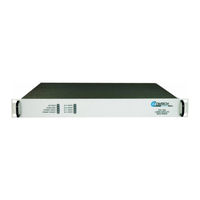Comtech EF Data Vipersat CDD-562L Manuals
Manuals and User Guides for Comtech EF Data Vipersat CDD-562L. We have 4 Comtech EF Data Vipersat CDD-562L manuals available for free PDF download: Installation And Operation Manual, User Manual
Comtech EF Data Vipersat CDD-562L Installation And Operation Manual (254 pages)
Demodulator with IP Module
Brand: Comtech EF Data
|
Category: Control Unit
|
Size: 8 MB
Table of Contents
-
Preface15
-
Grounding16
-
CE Mark19
-
Getting Help22
-
-
Overview25
-
Features29
-
Front Panel32
-
Rear Panel33
-
Demodulator36
-
-
-
-
-
Introduction57
-
-
-
Introduction81
-
SNMP Traps83
-
Mib-II84
-
Private MIB84
-
Unit Monitor87
-
Rx Monitor87
-
LNB Monitor87
-
-
-
Introduction93
-
Advertisement
Comtech EF Data Vipersat CDD-562L User Manual (176 pages)
Satellite Network Demodulator Router, Vipersat CDD-56X Series
Brand: Comtech EF Data
|
Category: Network Router
|
Size: 3 MB
Table of Contents
-
General
8-
-
-
Introduction18
-
Stdma20
-
Introduction23
-
-
-
Network Role24
-
-
-
-
-
Main Menu37
-
-
-
STDMA Mode42
-
Stdma43
-
Hub Type44
-
Dynamic Slot45
-
Fixed45
-
Gir45
-
Ecmv246
-
Ecmv2 Mode47
-
Group ID48
-
Outbound IP50
-
Set Remotes55
-
Base57
-
Remote Count57
-
-
-
SOTM Update72
-
Unit Role72
-
Network ID73
-
Unit Name74
-
-
-
STDMA State83
-
Alerts87
-
-
(Cli)
35 -
-
Introduction89
-
-
Layers 1 - 390
-
-
Binary Math92
-
-
Subnets96
-
Subnet Mask97
-
Comtech EF Data Vipersat CDD-562L User Manual (150 pages)
Vipersat CDD-56X Series Satellite Network Demodulator Router
Brand: Comtech EF Data
|
Category: Network Router
|
Size: 5 MB
Table of Contents
-
-
-
Introduction17
-
Stdma19
-
Introduction25
-
-
-
Network Role26
-
-
-
-
-
Main Menu39
-
-
-
STDMA Mode44
-
Stdma45
-
Hub Type46
-
Dynamic Slot47
-
Fixed47
-
Gir47
-
Group ID48
-
Outbound IP50
-
Set Remotes55
-
Base57
-
Remote Count57
-
-
-
SOTM Update71
-
Unit Role71
-
Network ID72
-
-
Unit Name73
-
-
(Cli)
37
Advertisement
Comtech EF Data Vipersat CDD-562L User Manual (144 pages)
Satellite Network Demodulator Router
Brand: Comtech EF Data
|
Category: Network Router
|
Size: 4 MB
Table of Contents
-
General
8-
-
-
Introduction18
-
Stdma20
-
-
Introduction25
-
-
Network Role26
-
-
-
-
General37
-
-
Main Menu39
-
-
-
STDMA Mode44
-
Hub Type46
-
Stdma46
-
Dynamic Slot47
-
Fixed47
-
Gir47
-
Group ID48
-
Outbound IP50
-
Set Remotes55
-
Base56
-
Remote Count57
-
-
-
Unit Role69
-
Network ID70
-
Unit Name70
-
-
STDMA State77
-
-
-
Introduction83
-
-
Layers 1 - 384
-
-
Binary Math86
-
-
Subnets90
-
Subnet Mask91
-



